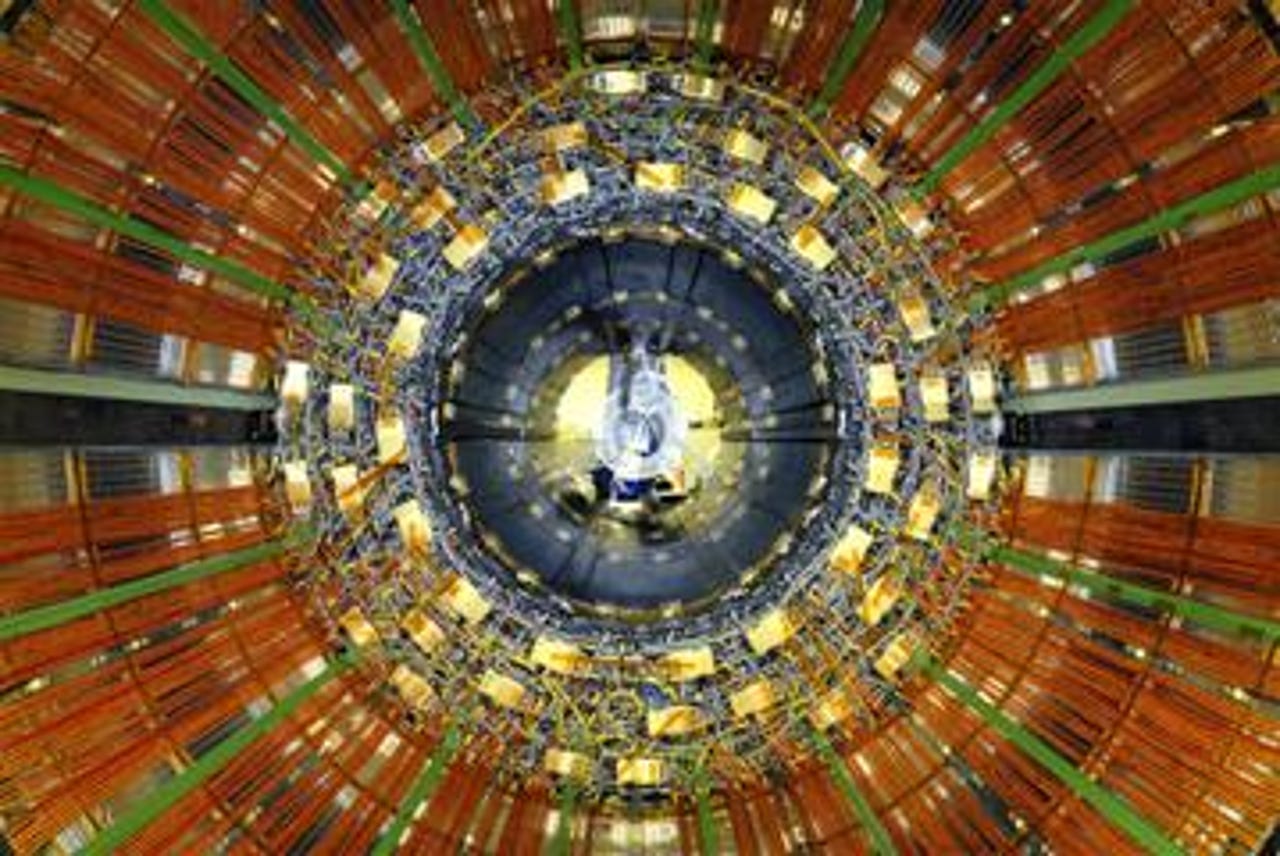Photos: The super-brain behind the particle smasher

How grid tech is sorting out the LHC...
When the Large Hadron Collider (LHC) is switched on this November it will be the world's most powerful particle accelerator, churning out roughly 15 million gigabytes of experimental data every year.
To make sense of all this information, Cern - the European centre for particle physics near Geneva which is building the collider – has put together a global grid to make sure the data is accessible to the 5,000 scientists around the world wanting a piece of the atom-smashing action.
The LHC is a 27km circular tunnel that straddles the border of France and Switzerland 100 metres underground - pictured is an aerial view of the collider's location.
The LHC is currently testing its grid infrastructure using simulated data which gets pumped out from the main centre to the 11 tier-one data centres where it will eventually be stored.
Francois Grey, head of the IT communications team at Cern, told silicon.com: "The data will come out at a phenomenal rate, every 25 nanoseconds there will be two bunches of protons colliding in the detector."
Photo credit: Cern

When the LHC is switched on, a series of magnets will accelerate the particle beams - which are fired in opposite directions - through the tunnels and when the beams collide, the energy of the crash ejects a spray of new particles.
Detecting and sifting through the billions of collisions will be the job of four main detectors along the length of the LHC.
The two largest detectors, Atlas and CMS (pictured), are hunting for the elusive Higgs particle - which is also called the 'God particle' as it is believed to give mass to other particles .
Grey said only one in every million collisions are put on the grid as electronics filtering systems within the detectors decide whether an event is "interesting" or not.
An interesting event would be when the full energy of a collision has gone into creating a new particle - using Einstein's famous e=mc2 equation, the more energy within a collision, the higher the chance of a previously undetected particle turning up because there is more energy available to transform into matter.
Grey added: "But even at that [one in one million] rate we're getting data at hundreds of megabytes per second from each detector and that means overall - as there are four big detectors - we're getting data of the order of gigabytes per second."
Photo credit: Cern
The LHC's grid network will use dedicated 10Gbps optical fibre links to connect 100,000 PCs around the globe - these computers are used to analyse the experimental data and compare it to theoretical simulations.
LHC's super-grid will use and support national and regional grid networks around the world - such as the GridPP project in the UK and a European project called Enabling Grids for E-Science in Europe (Egee).
Grey said: "It's not like the LCG [LHC Computing Project] has gone around digging holes and putting in cables but has piggy-backed on the huge advance in networking which makes it really possible to run a grid like this now."
Grey added the LCG has already started looking into using 40Gbps fibres but this will take a while to evolve.
Pictured is part of the third detector - called the Beauty experiment - which will search for particles that could explain why today's universe is mainly made up of matter and not anti-matter.
Photo credit: Cern
The LHC's grid uses a four-tiered model with a primary back-up recorded on a tape at Cern. After initial processing the data is then churned out to 11 tier-one data centres around the world.
The data is then filtered down to tier-two facilities with adequate computing power for specific analysis tasks.
Individual scientists can then access the tier-two facilities through tier-three computers – which consist of local clusters in a university department, or individual PCs.
Pictured is a view along the circular tunnel – the LHC is the tube on the left and is made up of a series of magnets which accelerate particles to near the speed of light around the collider before smashing them together.
Photo credit: Cern
The Egee is re-engineering existing grid software that has been originally developed by academics to produce a generic 'middleware' for the specific needs of the LHC's grid.
Grey said the middleware is needed to get the grid functioning in a smooth and invisible way so the data is available to academics in a transparent manner and without the need for passwords or knowing where the data is coming from - similar to the transparency of the web.
The development of the middleware is nearing completion and is currently in the production phase.
Grey added the LHC is a "curiosity driven experiment" and will not produce something that is directly useful to society so Cern is aware it should take advantage of anything that looks practical - such as this grid middleware which could be generalised and used by many scientists in the future.
The LHC and its detectors are housed in huge underground caverns - pictured is the descent of one of the more than 1,700 large magnets that make up the collider. The final magnet was installed on 26 April 2007.
Photo credit: Cern
The fourth detector - called Alice - will hunt for an extremely dense and exotic state of matter which is thought to have existed a fraction of a second after the big bang. For this, the LHC will collide heavy ions such as lead, rather than lighter protons.
Alice (pictured above) will also try to spot exotic new particles and validate theories that aim to unite three of the four fundamental forces of nature.
Photo credit: Cern
The CMS detector sits 100 metres underground - pictured is the final stages of the installation of one of the heaviest pieces of the detector's kit.
The pre-assembled central piece of the detector - which weighs 1,920 tonnes - was gently lowered into place using a huge gantry crane. The process took 10 hours to complete.
Photo credit: Cern